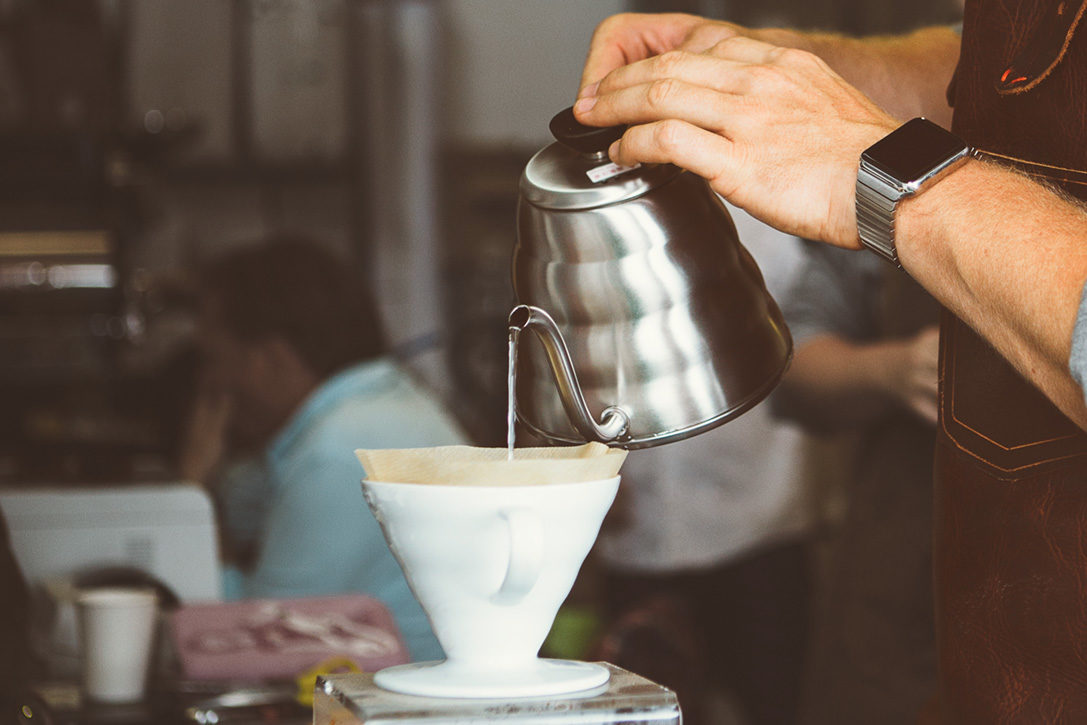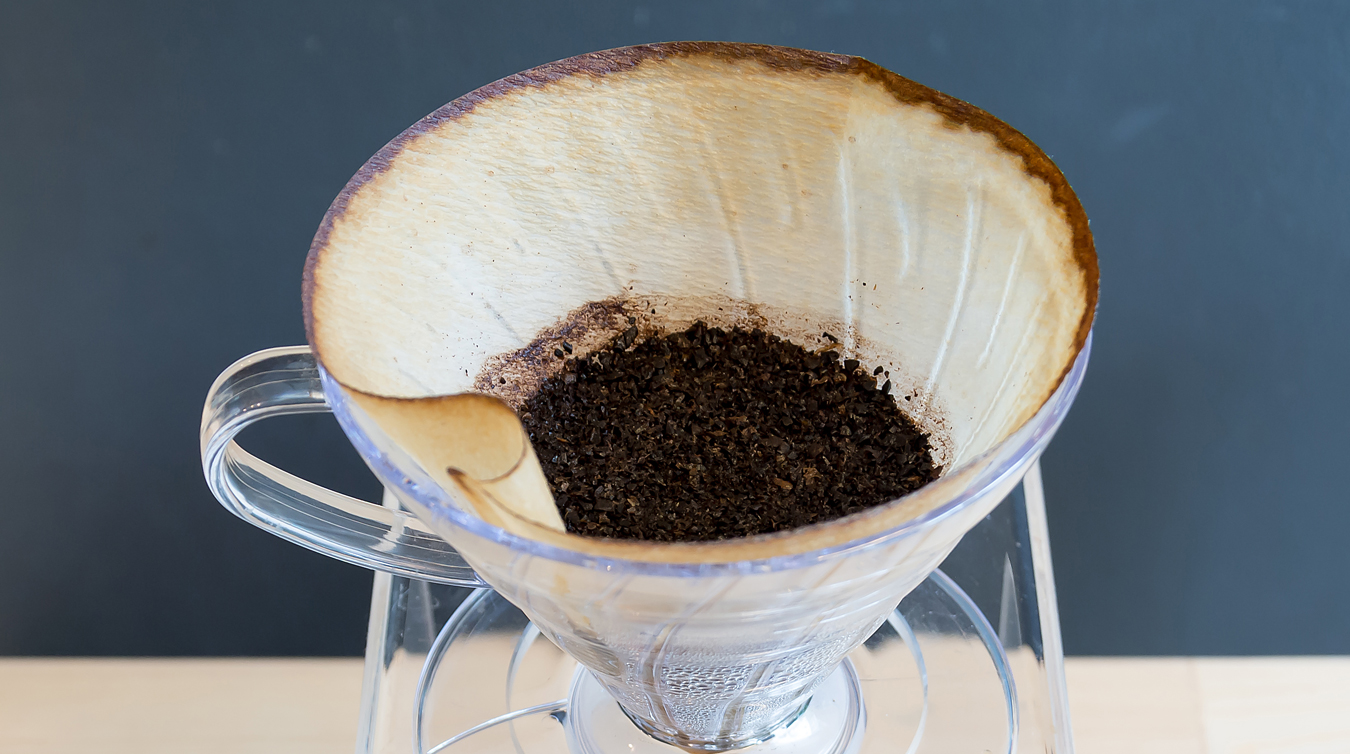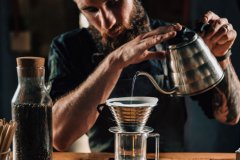The key to making coffee by hand _ five factors for beginners to make coffee

Professional coffee knowledge exchange more coffee bean information please follow the coffee workshop (Wechat official account cafe_style)
The key to making coffee by hand
In the coffee shops on the streets, some focus on the interior environment or the decoration on the coffee, selling the overall atmosphere and style. however, in addition to these decorations, fine coffee is slowly rising by simple taste, and more and more people are tasting the coffee noumen. there are also many people who begin to join the hand rush ranks, how do the beginners step into the hand rush world? How to judge the so-called good and bad? What is the basis of the popular scientific process on the market? One by one will be analyzed in this article.
According to the standards of different associations, it can be found that the extraction of coffee is basically based on the standard of a well, the horizontal axis is the extraction rate, and the vertical axis is the concentration. When the extraction rate is low, the sweet and sour feeling is more obvious, on the contrary, the bitterness is obvious. According to the fixed amount of powder, the extraction rate will be increased, and the concentration will also increase. The factors affecting the extraction rate and concentration can be discussed from the five points listed later in addition to the contact time of the final gouache. Under the interweaving of variables, the middle block is defined as good coffee, and the red heart of which point in the chart is 100 points varies from person to person, bitter and bitter, and everyone has different taste senses and preferences, so remember the taste you love. Adjusting to the goal and having a stable quality is the foundation of successful coffee.
Degree of grinding and evenness
In order to brew good coffee in a fresh state, most people will grind it into powder before brewing. Some people like the convenience of automatic grinding, others like the feeling of grinding by hand, no matter which type of particle size can be adjusted. The quality of the judging machine lies in whether it can be ground to a uniform size rather than the finer the better. The surface area of the particles in contact with the coarse powder is small, which will lead to insufficient extraction and waste of the powder. The taste is thin and the concentration is low. The over-fine contact surface area is large, at the same time, it will also slow down the flow velocity, and a large number of extraction components are easy to produce bitterness. if it is smaller than the pore size of the filter, it may overflow and affect the taste.
How to adjust the thickness will vary according to the extraction method, in the collocation of time to achieve a specific extraction rate, a longer time of extraction such as French filter pressure can use rough grinding to slow down the extraction, on the other hand, short-time extraction methods such as Italian coffee machine can use fine grinding to show the flavor.
Powder-water ratio
The more powder, the higher the concentration is a basic reflection idea, but for coffee, the amount of powder will also cause differences in taste sensations such as sour, sweet and bitter due to different degrees of extraction, so it is more clear to say that if you want to maintain the same degree of extraction and control the taste of sour, sweet and bitter, the more powder will take a little more time to extract, and the concentration will increase, otherwise the less the powder, the lower the concentration.
The powder-to-water ratio mentioned in the gold cup theory is based on the amount of powder to the total water supply rather than the total extraction. The ratio of powder to water is used from 1:10 to 1:20, and it is easier to fall into the defined gold block at 1:12-1:15, that is to say, one gram of powder to 12 to 15 grams of water. When the water-soluble substance in the powder is dissolved into water during coffee extraction, if 1 gram of substance is precipitated from 10 grams of powder, the extraction rate is 10%, so that the extraction rate is 18-22%. It would be appropriate to control the concentration of the dissolved substance between 1.15% and 1.45% of the coffee liquid. When the brewing time is fixed, the high powder-to-water ratio tends to be rich and sour, while the low powder-to-water ratio is bitter and light because of the high extraction rate, so it is obvious that the concentration and taste affect each other. Therefore, other factors such as time or grinding degree should be taken into account when making adjustments, and each link complements each other, so that another dimensional adjustment can be found in the linear relationship between concentration and taste.
For example, if the sweet and sour bitter taste brought by the degree of extraction is in line with the preference but the concentration is low, if you simply increase the amount of powder, in addition to increasing the concentration, it may also lead to a decrease in the degree of extraction, then it may be necessary to extend the soaking time to meet the demand.
Temperature and coffee beans
There are a variety of beans from different producing areas and different baking methods in the market, and some kinds and names of each store are different, but there will be basic classification, from shallow culture, shallow medium culture, medium culture, deep culture to deep culture, and so on. To put it simply, shallow culture is sour, but there are more fruity, floral and other aromas that lead to taste, while deep culture is bitter and has a heavy taste, with the taste of caramel or cocoa. In addition to the name, the store will attach simple signs and introductions to make it easier for buyers to imagine.
The main purpose of temperature control is to achieve consistency. The recommended water temperature of hand-brewed coffee is about 90 degrees. The temperature of shallow culture will be higher to lift the degree of extraction, while the temperature of deep culture can be reduced to a lower range between 80 and 90 degrees. In case the extraction rate is too high and bitterness is excessive, temperature is used to control the speed of extraction and brew flavor appropriately.
Extraction mode
The aroma and taste of coffee can be separated out in different ways, depending on temperature, pressure or time to achieve the effect. Different collocation designs are produced according to these ways, and there are different choices according to region or individual preference. The common mocha pot in Italy, the unique heating method of Turkish coffee, as well as siphon, French filter kettle, etc., the most common and easiest to start with is the hand brew combination. The choice of hand pots, filter cups, bottom pots and other equipment, different schools and techniques, how to control water flow and how to create disturbances have their own ideas, flexibility of change, and a sense of superiority in control. it brings a lot of discussion, communication and learning challenges for coffee lovers, which is very suitable for in-depth discussion.
water
The last item is water, which accounts for nearly 100% of the coffee product. Indirect products such as planting and breeding all emphasize the importance of water quality, not to mention that different producing areas and different degrees of filtration have a deeper impact on the seemingly transparent and pure substrate. Less is more, the more simple, the more prominent, the more simple, some people emphasize RO reverse osmosis water, distilled water, or mountain spring water. The softness and hardness of water and how many minerals it contains are also the focus of coffee researchers. Water that is suitable for drinking and contains some micro-minerals is also a good helper to bring into the drink, which can set off the flavor of coffee.
In this paper, we can find that there are too many factors and are interlinked, and to make a precise calculation, we need to design a complicated algorithm, and then incorporate the personalized customized elements, the complexity is unimaginable, a little more, a little less, the changes pulled under some micro-gaps can only be explained by words, the most important thing is to do it, try it, feel it, and then discover the fun, and create your own taste buds feast.
END
Important Notice :
前街咖啡 FrontStreet Coffee has moved to new addredd:
FrontStreet Coffee Address: 315,Donghua East Road,GuangZhou
Tel:020 38364473
- Prev

Choose a good filter cup to make good coffee! How to choose a coffee filter cup?
Professional coffee knowledge exchange More coffee bean information Please pay attention to coffee workshop (Weixin Official Accounts cafe_style) When you open the door and walk into a hand-brewed coffee shop, besides you want to taste a good cup of coffee, most of you also want to buy a brewing ceremony. It seems that only through this ritual can we enjoy this cup of good coffee calmly. suppose I
- Next

Five methods must be learned for hand-brewed coffee beans and water quality requirements for hand-brewed coffee
Professional coffee knowledge exchange more coffee bean information Please pay attention to the coffee workshop (Wechat official account cafe_style) there is always a kind of "your heart water" ~ when you have mastered the coffee beans and water quality requirements for hand-brewed coffee introduced in the first two articles, then you can learn the blending skills. There are many ways to brew coffee by hand, among which the following five methods are the most commonly used.
Related
- Beginners will see the "Coffee pull flower" guide!
- What is the difference between ice blog purified milk and ordinary milk coffee?
- Why is the Philippines the largest producer of crops in Liberia?
- For coffee extraction, should the fine powder be retained?
- How does extracted espresso fill pressed powder? How much strength does it take to press the powder?
- How to make jasmine cold extract coffee? Is the jasmine + latte good?
- Will this little toy really make the coffee taste better? How does Lily Drip affect coffee extraction?
- Will the action of slapping the filter cup also affect coffee extraction?
- What's the difference between powder-to-water ratio and powder-to-liquid ratio?
- What is the Ethiopian local species? What does it have to do with Heirloom native species?

